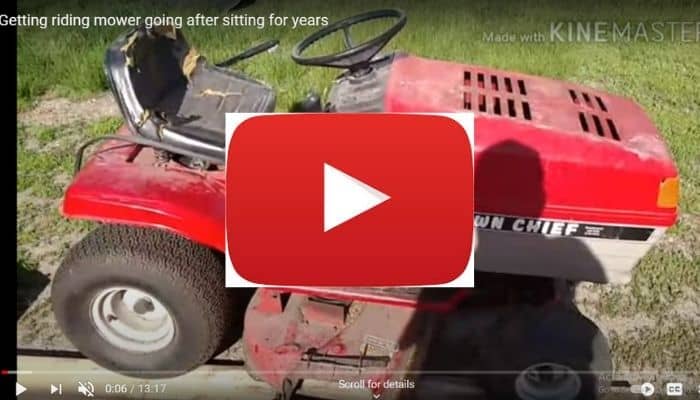In Brief: How to Start a Riding Lawn Mower That Has Been Sitting for Years
Charge the battery, change the oil, drain and replace any old fuel, then give the engine a general cleaning. Make sure to clean the carburetor with a can of carb spray. Replace the air filters and clean or replace the fuel and oil filters, if applicable. If the mower still won’t start, take it to a mechanic for further diagnostics.
If your riding mower has been sitting around unused for a long time, it may be difficult to get it to start up again. As long as you can figure out a few basic things about mower maintenance, you can learn how to start a riding lawn mower that has been sitting for years.
How to Start a Riding Lawn Mower That Has Been Sitting for Years: Detailed Answer
Mowers that have been sitting for too long can develop a number of problems. Go through this list one by one to check some of the most common problems and fix them.
- Step 1: Checking and Changing the Battery
Batteries tend to lose charge and fail after sitting for too long. If you have a test light at home, you can check the battery yourself. If not, you can charge the battery and try to start the mower.
To charge the battery, connect it to a dedicated battery charger and plug it in. Make sure you attach the negative and positive charging cables to the correct battery ports.
When the battery is fully charged, reattach it to the mower and try starting it again. Riding mowers use starting mechanisms that require battery power. If the engine doesn’t move when you turn the key, that’s a sign that the battery is not working.
Batteries that do not work even after being charged separately need to be replaced. Look for a new battery that matches the size and specifications of the old one or the requirements listed in the owner’s manual. - Step 2: Removing and Changing Engine Fluids
First, check the fuel. If there is fuel still in the mower, it’s likely gone bad and needs to be drained. On average, fuel lasts for around 30 days unless it’s been stabilized.
Here are a few ways to tell if the gas has gone bad:
• It’s darker than fresh gas
• It smells sour, with a stronger odor than usual
• The mower fails to start with gas in the tank, or stalls quickly
Bad gas should be drained from the mower. Check if your mower’s carburetor has a drain valve on the bottom to pour out the remaining old gas from the tank and fuel lines. If not, use a manual or electric siphon to pump it out.
Next, check the engine oil. If the mower has been sitting for a while, you should always change the oil. Even clean oil can degrade over time, making it less effective at lubricating the engine.
Drain out the old oil and refill it with fresh oil. Riding mowers should have an oil drain located at the bottom of the motor. Remove the drain plug and allow the oil to pour out until it stops. Replace the plug and refill the oil as directed by the owner’s manual. - Step 3: General Cleaning
Sometimes the problem with a riding lawn mower that’s been sitting for years is that there’s dirt, grime, or debris preventing the engine from running properly. Cleaning the engine can help.
First, take a dry rag, shop vac, leaf blower, or something similar and clean all the visible debris from around the engine bay. There’s likely to be grass and dirt around the engine, so take your time to remove as much as possible without taking off any of the parts.
Next, do a general check of all the filters built into the engine. All mowers have air filters attached to the carburetor, but some also have oil filters and gas filters.
Air filters that have been sitting can be covered in dust and dirt, or they may be damaged. Inspect the air filter and replace it if it looks too dirty or if there’s any obvious damage. Inspect and clean the oil and fuel filters as well if your mower is equipped with them.
Lastly, you’ll need to clean the carburetor. Use a spray can of carb cleaner to do a quick clean. Make sure to spray the carburetor thoroughly, including spraying into the drain valve at the bottom or inside through the fuel or air intake.
If you want to take your cleaning a step further, put specialized fuel and oil additives into your engine fluids to clean the inside of the engine and all fluid lines. - Step 4: Diagnosing Additional Problems
Try the riding mower again. If it still isn’t starting, there could be issues with another integral system. Inspect these systems to check for any obvious problems first:
• Engine belts
• Starter
• Fuel lines
• Wiring
• Carburetor
• Gaskets & sealing components
• Spark plus
Some problems with these engine systems are obvious. Leaks, breaks, or visible wear and tear might be the reason your mower won’t start or run properly. If there are no apparent problems, you may need to take your mower to the mechanic for a more complete diagnosis.
See a riding lawn mower diagnostic in action here:

- Step 5: Running the Mower
If over the course of steps 1-4 you manage to start the mower, allow the mower to run for a few minutes before you start cutting the grass or before you turn off the mower.
Running the mower allows lubricant to circulate throughout the engine and for clean fuel to replace old fuel in the lines and carburetor. By keeping the mower running for a few minutes, you’re giving the engine its best chance of starting up immediately the next time you turn it on.
Conclusion
Riding mowers that have been sitting for years are usually able to be revived. All it takes is a little attention to the right areas of the engine and you may be able to get your mower up and running once again.
Do you have questions about how to start a riding lawn mower that has been sitting for years? Leave a comment below.


